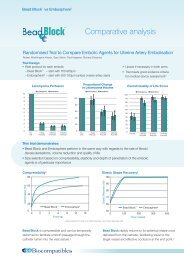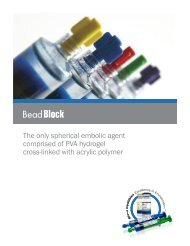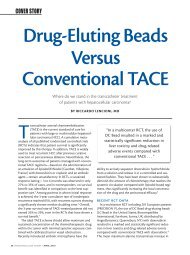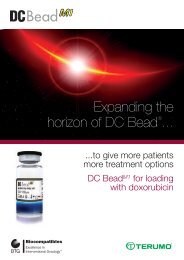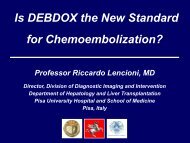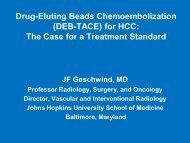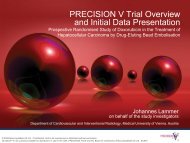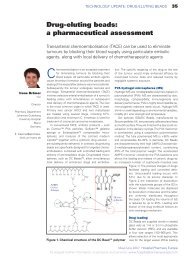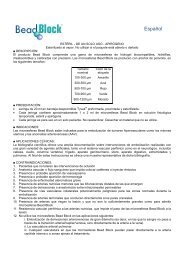DC Bead Information Brochure.pdf - Biocompatibles
DC Bead Information Brochure.pdf - Biocompatibles
DC Bead Information Brochure.pdf - Biocompatibles
Create successful ePaper yourself
Turn your PDF publications into a flip-book with our unique Google optimized e-Paper software.
Drug Delivery Embolisation System for<br />
PRECISION TACE<br />
Less<br />
Lower systemic<br />
doxorubicin 2,3<br />
“<strong>DC</strong> <strong>Bead</strong> can be loaded with doxorubicin to<br />
provide accurate dosage of the drug - making it<br />
suitable for superselective [PRECISION] TACE. 1 ”<br />
More<br />
Higher doxorubicin<br />
dose in the tumour<br />
for longer 3,4<br />
Every<br />
Time<br />
Consistent treatment<br />
from a consistent<br />
product 2
Drug Delivery Embolisation System for PRECISION TACE<br />
Efficacy, confidence and convenience<br />
97%<br />
of physicians rated the<br />
embolisation result<br />
as good or excellent 2<br />
“The drug eluting bead is a<br />
promising option. Our patients have<br />
tolerated the treatment well. 3<br />
Dr Ronnie Poon, Queen Mary Hospital, Hong Kong”<br />
87%<br />
of physicians<br />
indicated that in<br />
their experience<br />
PRECISION TACE<br />
with <strong>DC</strong> <strong>Bead</strong> was<br />
“better” than current<br />
treatment 2 86%<br />
of physicians<br />
reported a reduced<br />
incidence of sideeffects<br />
compared<br />
with conventional<br />
TACE 2<br />
“Favourable pharmacokinetic<br />
profile should prompt a better<br />
tolerance to treatment with reduction<br />
”<br />
of drug related toxicity. 4<br />
Dr M. Varela, Barcelona Liver Cancer Clinic, Spain<br />
“TACE with doxorubicin eluting<br />
beads [PRECISION TACE with<br />
<strong>DC</strong> <strong>Bead</strong> ] is well tolerated (in<br />
neuroendocrine carcinoma).<br />
”<br />
5<br />
Prof Thierry DeBaere, Institut Gustave Rousy, Villejuif, France
Less<br />
More<br />
Every<br />
Time<br />
Specifically designed for the controlled<br />
loading and delivery of oncolytic drugs,<br />
<strong>DC</strong> <strong>Bead</strong> Drug Delivery Embolisation<br />
System brings a new level of efficacy,<br />
confidence and convenience to trans-arterial<br />
chemo-embolisation: PRECISION TACE.<br />
Developed from a sulphonate-modified N-Fil<br />
hydrogel, PRECISION TACE with <strong>DC</strong> <strong>Bead</strong> has<br />
been proven effective in the treatment of<br />
hepatocellular carcinoma (HCC), neuroendocrine<br />
carcinoma and other malignant tumours. 3,4,5<br />
PRECISION TACE with <strong>DC</strong> <strong>Bead</strong> is supported by an extensive programme of clinical trials.
PRECISION TACE<br />
Drug Delivery Embolisation System for<br />
Designed to improve patient outcomes<br />
More<br />
Improved Response and Reduced Complications with<br />
PRECISION TACE with <strong>DC</strong> <strong>Bead</strong> <br />
Improving response<br />
“<br />
Objective response<br />
was 78% at 6 months<br />
with <strong>DC</strong> <strong>Bead</strong> (87%<br />
at 150mg dose) with<br />
no dose limiting<br />
drug toxicity. 4<br />
”<br />
Less<br />
Pharmacokinetic Profile of Systemic Doxorubicin<br />
Lowering toxicity<br />
“<br />
Mean systemic<br />
doxorubicin was 30<br />
times lower in patients<br />
treated with <strong>DC</strong> <strong>Bead</strong> <br />
vs those treated with<br />
conventional TACE. 4<br />
”
Less<br />
More<br />
Every<br />
Time<br />
Every Time<br />
Consistent delivery ensuring<br />
continued drug delivery to the<br />
tumour over an extended period<br />
“<br />
The degree of variability<br />
of Cmax in drug eluting<br />
bead [<strong>DC</strong> <strong>Bead</strong> ] treated<br />
patients was lower than<br />
in those treated with<br />
conventional TACE, with<br />
no relationship to the<br />
administered dose. 4<br />
”<br />
<strong>DC</strong> <strong>Bead</strong> loaded with<br />
doxorubicin has been<br />
studied in a number of<br />
pre-clinical models<br />
Porcine Liver 28 Days after Embolisation with<br />
Unloaded and Doxorubicin Loaded <strong>DC</strong> <strong>Bead</strong> 2<br />
Unloaded <strong>DC</strong> <strong>Bead</strong> - necrosis remains local to<br />
the bead<br />
Doxorubicin loaded <strong>DC</strong> <strong>Bead</strong> - necrosis extends<br />
beyond location of the bead as a result of sustained<br />
doxorubicin release over an extended period<br />
* Necrosed Tissue<br />
PRECISION TACE:<br />
1 hour post treatment 8<br />
<strong>Bead</strong>s<br />
Fibrous tissue<br />
Viable tumour<br />
PRECISION TACE:<br />
14 days post treatment 8<br />
Eluted doxorubicin from the beads<br />
Completely necrosed liver tumour tissue
Drug Delivery Embolisation System for PRECISION TACE<br />
Targeted embolisation combined with<br />
Every Time<br />
<strong>DC</strong> <strong>Bead</strong> 700-900μm<br />
Loaded with 25mg/ml Doxorubicin<br />
<strong>DC</strong> <strong>Bead</strong> primary embolic<br />
characteristics allow accurate,<br />
targeted delivery<br />
A narrow distribution of calibrated beads<br />
“<br />
Catheter delivery experiments<br />
showed that all beads were<br />
easily deliverable without<br />
aggregation or occlusion of the<br />
catheter with drug loading doses<br />
as high as 37.5mg/ml. 1<br />
”<br />
Before Delivery<br />
After Delivery<br />
“<br />
Compressibility and rigidity is<br />
maintained during and after<br />
catheter delivery. 1<br />
”<br />
<strong>DC</strong> <strong>Bead</strong> 500-700μm loaded with 25mg/ml doxorubicin before<br />
and after delivery through a 2.7F microcatheter. 2
Less<br />
consistent drug delivery...<br />
More<br />
Every<br />
Time<br />
Every Time<br />
An easy to use product<br />
specifically designed to load<br />
and elute drugs in a controlled<br />
and reproducible profile<br />
supported by technical data for<br />
increased user confidence<br />
Drug Loading<br />
<strong>DC</strong> <strong>Bead</strong> Drug Delivery Properties<br />
• Loads and elutes drugs relevant to clinical use<br />
• Uniform distribution of drug throughout the<br />
loaded beads<br />
• Consistent local delivery to the tumour, over an<br />
extended period<br />
Hydrated <strong>Bead</strong>s<br />
Loaded <strong>Bead</strong>s<br />
“<br />
Doxorubicin interacts with<br />
<strong>DC</strong> <strong>Bead</strong> sulphonate groups. 1<br />
”<br />
Hydration shell<br />
associated with<br />
ionic groups<br />
Bulk<br />
(non-bound)<br />
water<br />
Interaction of doxorubicin<br />
with SO-<br />
3 groups displaces<br />
water from the hydration<br />
shells
...over an extended time period<br />
For Longer 1<br />
In Vitro Doxorubicin Elution<br />
PRECISION TACE vs TACE 1<br />
With <strong>DC</strong> <strong>Bead</strong> drug elution is<br />
dependent on ion exchange and is<br />
controlled and sustained - unlike<br />
the rapid separation of the drug<br />
from Lipiodol ®<br />
“<br />
<strong>DC</strong> <strong>Bead</strong> should enable<br />
delivery of drug to the<br />
tumour site over an<br />
extended period while<br />
minimising systemic release<br />
of doxorubicin and reducing<br />
the side effects associated<br />
with conventional TACE. 1<br />
”<br />
• The elution half life of doxorubicin from <strong>DC</strong> <strong>Bead</strong> <br />
ranged from 6-72 days, depending on bead size<br />
Doxorubicin (25mg) in Saline (2.5ml)<br />
+ Lipiodol ® (2.5ml)<br />
White areas are<br />
unassociated Lipiodol ®<br />
droplets<br />
• Doxorubicin was lost from Lipiodol ® within 4 hours<br />
• The oily phase of Lipiodol ® did not associate with<br />
doxorubicin<br />
• Lipiodol ® does not help carry doxorubicin to the<br />
tumour bed
Less<br />
easy preparation<br />
More<br />
Every<br />
Time<br />
<strong>DC</strong> <strong>Bead</strong> has been designed to offer<br />
improved operator safety and easy preparation<br />
and handling<br />
To give required dose of drug<br />
50mg 100mg 150mg<br />
Doxorubicin vials (50mg) 1 2 3<br />
<strong>DC</strong> <strong>Bead</strong> vials 1 2 2<br />
Doxorubicin solution per <strong>DC</strong> <strong>Bead</strong> vial (ml) 2 2 3<br />
STEP 1<br />
Reconstitute each 50mg<br />
doxorubicin vial with 2ml of<br />
sterile water for injection.<br />
Mix well to obtain a clear<br />
solution.<br />
“ <strong>DC</strong> <strong>Bead</strong> loading can be performed<br />
easily - a one step TACE procedure that<br />
avoids the use of caustic and unstable<br />
chemotherapy mixtures. 1<br />
”<br />
STEP 3<br />
Using a syringe and needle add<br />
the reconstituted doxorubicin<br />
solution directly to the vial(s) of<br />
<strong>DC</strong> <strong>Bead</strong> .<br />
STEP 4<br />
Agitate the <strong>DC</strong> <strong>Bead</strong> /<br />
doxorubicin solution gently to<br />
encourage mixing then allow to<br />
stand until the beads are red and<br />
the solution is almost colourless.<br />
STEP 2<br />
Remove as much saline as<br />
possible from <strong>DC</strong> <strong>Bead</strong> vial(s)<br />
using a syringe with a small<br />
gauge needle.<br />
Pierce bung with a second<br />
needle to eliminate vacuum.<br />
STEP 5<br />
<strong>DC</strong> <strong>Bead</strong> loading time is<br />
dependent on bead size.<br />
If a filter needle is not<br />
STEP 6<br />
available, place<br />
flattened tip of needle<br />
against side of vial to<br />
prevent beads being<br />
drawn up the needle.<br />
Transfer the loaded beads into a<br />
10ml syringe. Add an equal<br />
volume of non-ionic contrast<br />
media and mix gently (a 3-way<br />
connector and second syringe<br />
can be used).
Drug Delivery Embolisation System for<br />
PRECISION TACE<br />
<strong>Biocompatibles</strong> is a world technology leader in the development of Combination Products - medical devices combined with an active pharmaceutical agent to provide<br />
targeted and controlled delivery of the drug. A leader in the development of drug elution technology, <strong>Biocompatibles</strong> was one of the first companies to develop a drug eluting<br />
coronary stent. The company licenses drug elution technology to leading medical device manufacturers worldwide. The company focuses on developing Combination<br />
Products to treat cancer, benign tumours and cardiovascular disease.<br />
Working to rigorous external and internal quality standards, all <strong>Biocompatibles</strong>' laboratories and procedures are ISO 9001 approved and comply with GLP. Where possible,<br />
product testing is carried out to ICH standards. Internal standards regarding data published by the company include the following:<br />
• Data will be presented in a clear and unambiguous manner.<br />
• Terminology used will be clearly defined:<br />
Compatibility: The drug-bead combination is considered compatible if the two can be combined with no irreversible interaction over a period typically required for loading and<br />
delivery of the combination. This is demonstrated by post-elution evaluation to determine that the properties of the drug and bead are the same as prior to loading and delivery.<br />
Stability: Stability refers to the long-term interaction between the drug and the bead, and the combination can be considered stable if there is no notable degradation of the<br />
bead or drug once stored under specified conditions over a specified period, typically 1-7 days.<br />
• Where data have been generated inside the company, the methodology or monograph used will be summarised.<br />
If you would like further information on any of the methodology used, please contact us and we will arrange for one of our research scientists to speak to you.<br />
• Where data have been generated outside the company, full reference to the source will be given.<br />
Summarised below are the sources of data provided in this piece.<br />
References<br />
1. Lewis, A.L., Gonzalez, V., Lloyd A.W., et al. <strong>DC</strong> <strong>Bead</strong> : In Vitro Characterization of a Drug-delivery Device for Transarterial Chemoembolization. JVIR 17:335-342 (2006).<br />
2. Data on file. <strong>Biocompatibles</strong> UK Ltd.<br />
3. Poon, R., Treatment of Asian Patients with Hepatocellular Carcinoma (HCC) using doxorubicin Eluting <strong>Bead</strong> Embolization (PRECISION ASIA STUDY). Presentation at<br />
CIRSE 2004.<br />
4. Varela, M., Real, M., et al. Chemoembolization of hepatocellular carcinoma with drug eluting beads reduces the systemic availability of doxorubicin. A pharmacokinetic<br />
assessment. Poster presentation. AASLD 2005.<br />
5. Coenegrachts, K., DeBaere, T., et al. TransArterial ChemoEmbolization (TACE) of Neuroendocrine Hepatic Metastases Using Drug-Eluting <strong>Bead</strong>s. Presentation RSNA 2005.<br />
6. Llovet, J.M., Real, M.I., Montaña X, et al. Arterial embolisation or chemoembolisation versus symptomatic treatment in patients with unresectable hepatocellular<br />
carcinoma: a randomised controlled trial. Lancet 2002; 359:1734-1739.<br />
7. Lammer, J. Clinical Experience with Drug Eluting <strong>Bead</strong> (<strong>DC</strong> <strong>Bead</strong> ) for Chemoembolisation of Unresectable Hepatocellular Carcinoma. Presentation at CIRSE 2005.<br />
8. Hong, K., Khwaja, A., Liapi, E., Torbenson, M.S., Georgiades, C.S., and Geschwind, J.F.H. New Intra-arterial Drug Delivery System for the Treatment of Liver Cancer:<br />
Preclinical Assessment in a Rabbit Model of Liver Cancer. Clin Cancer Res 2006;12(8), 2006<br />
<strong>DC</strong> <strong>Bead</strong> is a trademark of <strong>Biocompatibles</strong> UK Ltd<br />
Lipiodol ® is a registered trademark of Guerbet S.A., France<br />
Manufactured by <strong>Biocompatibles</strong> UK Ltd, Chapman House,<br />
Farnham Business Park, Weydon Lane, Farnham, Surrey,<br />
GU9 8QL, UK. www.biocompatibles.com<br />
EC548 © 2006 <strong>Biocompatibles</strong> UK Ltd


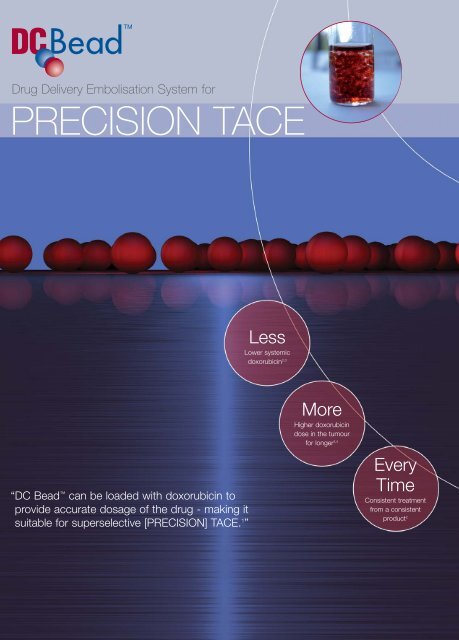
![Drug-Eluting Bead TACE with DC Bead® [DEBDOXâ¢] in the ...](https://img.yumpu.com/50840371/1/184x260/drug-eluting-bead-tace-with-dc-beadar-debdoxa-in-the-.jpg?quality=85)

